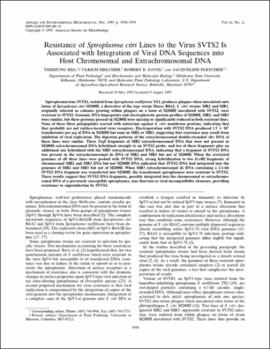| dc.contributor.author | Sha, Yehsiung | |
| dc.contributor.author | Melcher, Ulrich | |
| dc.contributor.author | Davis, Robert E. | |
| dc.contributor.author | Fletcher, Jacqueline | |
| dc.date.accessioned | 2018-08-17T16:24:51Z | |
| dc.date.available | 2018-08-17T16:24:51Z | |
| dc.date.issued | 1995-11 | |
| dc.identifier | oksd_y.sha_resistanceofspi_1995 | |
| dc.identifier.citation | Sha, Y., Melcher, U., Davis, R. E., & Fletcher, J. (1995). Resistance of Spiroplasma citri lines to the virus SVTS2 is associated with integration of viral DNA sequences into host chromosomal and extrachromosomal DNA. Applied and Environmental Microbiology, 61(11), 3950-3959. https://doi.org/10.1128/aem.61.11.3950-3959.1995 | |
| dc.identifier.uri | https://hdl.handle.net/11244/301436 | |
| dc.description.abstract | Spiroplasmavirus SVTS2, isolated from Spiroplasma melliferum TS2, produces plaques when inoculated onto lawns of Spiroplasma citri M200H, a derivative of the type strain Maroc R8A2. S. citri strains MR2 and MR3, originally selected as colonies growing within plaques on a lawn of M200H inoculated with SVTS2, were resistant to SVTS2. Genomic DNA fingerprints and electrophoretic protein profiles of M200H, MR2, and MR3 were similar, but three proteins present in M200H were missing or significantly reduced in both resistant lines. None of these three polypeptides reacted with antiserum against S. citri membrane proteins, indicating that they probably are not surface-located virus receptors. Electroporation with SVTS2 DNA produced 1.5 x 10(sup5) transfectants per (mu)g of DNA in M200H but none in MR2 or MR3, suggesting that resistance may result from inhibition of viral replication. The digestion patterns of the extrachromosomal double-stranded (ds) DNA of these lines were similar. Three TaqI fragments of MR2 extrachromosomal DNA that were not present in M200H extrachromosomal DNA hybridized strongly to an SVTS2 probe, and two of these fragments plus an additional one hybridized with the MR3 extrachromosomal DNA, indicating that a fragment of SVTS2 DNA was present in the extrachromosomal ds DNA of MR2 and MR3 but not of M200H. When the restricted genomes of all three lines were probed with SVTS2 DNA, strong hybridization to two EcoRI fragments of chromosomal MR2 and MR3 DNA but not M200H DNA indicated that SVTS2 DNA had integrated into the genomes of MR2 and MR3 but not of M200H. When MR3 extrachromosomal ds DNA containing a 2.1-kb SVTS2 DNA fragment was transfected into M200H, the transformed spiroplasmas were resistant to SVTS2. These results suggest that SVTS2 DNA fragments, possibly integrated into the chromosomal or extrachromosomal DNA of a previously susceptible spiroplasma, may function as viral incompatibility elements, providing resistance to superinfection by SVTS2. | |
| dc.format | application/pdf | |
| dc.language | en_US | |
| dc.publisher | American Society for Microbiology | |
| dc.rights | This material has been previously published. In the Oklahoma State University Library's institutional repository this version is made available through the open access principles and the terms of agreement/consent between the author(s) and the publisher. The permission policy on the use, reproduction or distribution of the material falls under fair use for educational, scholarship, and research purposes. Contact Digital Resources and Discovery Services at lib-dls@okstate.edu or 405-744-9161 for further information. | |
| dc.title | Resistance of Spiroplasma citri lines to the virus SVTS2 is associated with integration of viral DNA sequences into host chromosomal and extrachromosomal DNA | |
| osu.filename | oksd_y.sha_resistanceofspi_1995.pdf | |
| dc.description.peerreview | Peer reviewed | |
| dc.identifier.doi | 10.1128/aem.61.11.3950-3959.1995 | |
| dc.description.department | Plant Pathology | |
| dc.description.department | Biochemistry and Molecular Biology | |
| dc.type.genre | Article | |
| dc.type.material | Text | |
| dc.subject.keywords | plant pathogen | |
| dc.subject.keywords | podoviridae | |
| dc.subject.keywords | sensitivity resistance | |
| dc.subject.keywords | mechanism | |
| dc.subject.keywords | host virus relation | |
| dc.subject.keywords | molecular integration | |
| dc.subject.keywords | dna | |
| dc.subject.keywords | spiroplasmataceae | |
| dc.subject.keywords | mycoplasmatales | |
| dc.subject.keywords | mollicutes | |
| dc.subject.keywords | bacteria | |
| dc.subject.keywords | phage | |
| dc.subject.keywords | virus | |
